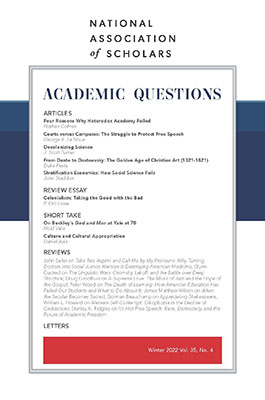John Staddon is James B. Duke Professor of Psychology, and Professor of Biology emeritus at Duke University; [email protected]. Three recent books are The New Behaviorism: Foundations of behavioral Science, 3rd edition (Psychology Press, 2021), Unlucky Strike: Private Health and the Science Law and Politics of Smoking, 2nd edition, (2022 PsyCrit Press), and Science in an Age of Unreason (Regnery, 2022). He last appeared in these pages in spring 2021 with his article “History of Science: Politicizing a Discipline.”
Social science is tough, for at least three reasons. First, the subject under study, the behavior of human beings individually and collectively, is complex. Second, in most cases you can’t do experiments. You can’t try out one social system, reset after a few years, try another, then compare the results. And third, causes and effects may be separated by long stretches of time. Conditions now may be the product of events long in the past. This complexity has so far denied social science the kind of organizing framework provided for “hard-science” fields by well-established physical, chemical, and biological laws.
Science is naturally subdivided into specialties and sub-specialties. In the physical sciences this isn’t too much of a problem because all share a common framework. Chemistry acknowledges the laws of physics and vice versa. Even in biology, there is a shared framework: species classification, evolution, genetics, etc. Social science is not subject to this kind of restraint. Moreover, professional incentives (career need to publish, get research grants etc.) favor fission and “niche creation.” As a result the professional associations for psychology (which is mostly social) and sociology (which is all social) have subdivided into more than one hundred divisions. Criticism is then confined to each division. No chance for an experimental psychologist to vet, say, a paper on race and gender studies. Papers in the sociological section on “Race, Gender, and Class” are unlikely to get much input from researchers in “Science, Technology, and Society,” for example. It is only a slight exaggeration to say each division provides a safe harbor for like-minded researchers.
Stratification Economics
Economics is “a social science concerned chiefly with description and analysis of the production, distribution, and consumption of goods and services.” It considers itself independent from sociology and even psychology, although a few interdisciplinary forays have been made.
Despite its intentional separation from the rest of social science, economics is also subdivided. The American Economic Association has some twenty subfields (“JEL" codes1), ranging from “General Economics and Teaching” to “Other Special Topics.” Each of these has half a dozen or more further sub-subfields. The subdivisions within economics have the same downside as other subdivisions; they limit criticism. Once a new area is permitted its own code, it gains some standing as well as being sheltered from critical scrutiny. Perhaps this is why there is sometimes contention about an application for a new code. The rather chaotic situation in economics and the rest of social science can lead to some extraordinary departures from normal scientific practice. I will discuss one illustrative example: the attempt to establish a new subfield of “Stratification Economics” (SE).
William Darity, a distinguished professor of Public Policy, African American Studies, and Economics at Duke University, writes, “On February 11, 2005, my presentation, in Charleston, South Carolina, of the Academy of Economics and Finance’s J. Anderson Davis lecture launched the subfield of stratification economics.”2
SE is concerned with income and wealth disparities between races. Superficially it might seem that SE belongs in the JEL area J: Labor and Demographic Economics, but Darity and his congeners wanted a separate subfield:
It has been difficult to gain formal professional recognition of stratification economics as a subfield . . . [S]tratification economics was relegated to the final catchall area of the JEL classification scheme, “Z. Other Special Topics.” Next, it was buried under “Z1. Cultural Economics, Economic Sociology, and Economic Anthropology,” despite the fact that stratification economics rejects cultural determinism and despite the fact that stratification economics is not a subdivision of either sociology or anthropology, although influenced by both. [emphasis added]
Darity describes the difficulty he encountered trying to publish an SE paper in the mainstream Journal of Economic Perspectives. The paper finally wound up in a book, The Hidden Rules of Race, less visible to economists.
It is worth looking a little deeper into this rather arcane dispute to understand just what is going on with economics. First, SE appears to have two objectives, one of which is to explain the reasons for the “significant and enduring disparities in income and wealth by social groups, particularly by race and gender, especially those associated with discrimination in labor and housing markets.” Fair enough: SE is concerned with the causes of racial group disparities.
The second objective, as Darity describes it, is more troubling in that it seeks to omit some potential causal factors from research relating to racial group disparities:
The objective [of SE] was to perform bypass surgery on the argument that groups in a subordinate position are so ranked because of their own deficiencies or self-defeating behaviors. The idea that group-based inequalities are due to defective cultural habits and practices on the part of the subaltern (or subordinated) community poses a conceptual occlusion that requires circumvention. [emphases added]
In other words, SE explicitly excludes from its analysis of group disparities anything to do with the interests and abilities of the individuals involved—which would only be legitimate if those factors have been proven to be irrelevant to socioeconomic variables. Otherwise, SE economists are left in the position of Aristotle when he concluded that heavier bodies fall faster than light ones: Aristotle was, of course, wrong, as Galileo showed, because he ignored air drag, which slows light bodies more than heavy ones.
Aristotle can be excused his ignorance. But economic disparities cannot be understood if endogenous3 differences, average differences in the interests and abilities of disparate groups, are a priori excluded. Individuals differ as do many groups, including racial groups, on behavioral measures vital to socioeconomic success. Nevertheless, SE expressly rejects group differences as any part of an explanation, which leaves exogenous factors—the social, legal, and economic environment (“structural forces”) —as the only possible cause for disparities.
A semi-official source summarizes SE forthrightly as follows:
[T]his explicitly moral research discipline [Stratification Economics] recognizes that structural forces limiting opportunities for Black Americans were set up by white Americans to preserve their economic dominance. . . . [Racial] inequities are the direct, intentional result of the institutions, laws, and norms that were established to maintain the economic dominance of white Americans.4 [emphases added]
This comment raises two seemingly intractable problems for including SE as a social science subfield. First “intentional result” alleges that laws and norms (even, or perhaps especially, laws that make no mention of race) were explicitly engineered to disadvantage people of color. This is a very strong charge that is almost impossible to prove or disprove. Certainly no law since the mid-1960s has expressed any such intention. Unfortunately, unproven allegations of this sort, attributing malign motives to whole classes, either the bourgeoisie (by Marx) or white people (by Darrity and many others), are common in this literature.
Second, “moral” issues are certainly important for making policy, but they have no place in a scientific account. The scientific issue is always just the causes and processes involved in the phenomenon under study. Verifiable truth is the only concern for science, even social science. Whether the result is good or bad is a matter for religion, law, and politics to decide.
Inherited Wealth?
The empirical problem addressed by SE is disparities of income and, especially, wealth between black Americans and the general population. Wealth disparities appear to be very large (although it must be admitted that measuring wealth is less precise than measuring income, since the IRS is not yet involved). The usual behavioral science approach5 to this problem would be to begin by looking at both endogenous and exogenous causes: at the interests and abilities of individuals and the conditions—social, legal, and cultural as well as economic—acting on them. In a dramatic break with the standard approach, Darity admits at the outset that that SE intentionally ignores endogenous causes: it “rejects cultural determinism” and “[t]he idea that group-based inequalities are due to defective cultural habits and practices on the part of the subaltern (or subordinated) community poses a conceptual occlusion that requires circumvention.”
Again the language is extra-scientific. In what sense does a scientific hypothesis “require circumvention” as opposed to disproof? Is this part of SE’s claim to be a “moral” science? In fact it seems to remove SE from science entirely.
Darity contends that racial behavioral disparities (criminality, cognitive differences, marriage rates, etc.) reflect wealth differences rather than average group or individual (endogenous) differences: “When wealth is taken into account virtually every group-based disparity in behavior customarily attributed to racial differences in cultural orientation disappears.”6 The causal problem with Darity’s claim is that wealth could be a dependent rather than an independent variable. Instead of wealth acting on various behaviors, behaviors can and do act on wealth. High rates of criminality can reduce wealth (e.g., property values fall in high crime areas) and high academic achievement can increase wealth (better paying jobs). So the precise direction of cause and effect is uncertain.
Wealth is often an outcome of the individual’s interests and abilities and the opportunities available to him. There are also inverse correlations between wealth and criminality—wealthier people are less likely to commit most types of crime—and positive correlations between wealth and cognitive ability—wealthy people tend to score higher on cognitive tests. But the causal relationships are not well understood. We do know that a low scorer on a cognitive test will not become smarter if he wins the lottery; and also that work and intelligence can generate wealth; and I describe in a moment experimental evidence on the irrelevance of wealth to cognitive performance. But I begin with the more difficult question of crime.
Blacks are implicated in crime at many times the rate for whites and Asians. The Centers for Disease Control (CDC) in a 2017 report concludes: “the homicide rate among African-Americans is nearly quadruple that of the national average” and some eight times the rate for whites.7 Statistics on other kinds of crimes in various locations (cities, smaller towns, etc.) are well summarized in Charles Murray’s 2021 book, Facing Reality.8 Invariably, blacks score much higher than whites or Asians on most crime measurements. Tying these differences to wealth, as Darity proposes, would require a comparison of whites and blacks with comparable wealth to see if they have similar crime rates. Individual data on wealth (which includes asset values) is difficult to come by, but at least one group of scholars had a good try, and the findings do pose problems for SE.
The Harvard University sponsored Opportunity Insights study, “Race and Economic Opportunity in the United States: An Intergenerational Perspective,” used a database consisting of virtually the entire American population from 1989-2015. The study analyzed data from the 2000 and 2010 decennial censuses linked to data from federal income tax returns and the 2005-2015 American Community Surveys. It found racial disparities in adult income even when childhood households are of equal income and wealth. Focusing on children in the 1978-1983 birth cohorts, Harvard’s Raj Chetty, Stanford’s Nathaniel Hendren, and two census researchers, Maggie R. Jones and Sonya R. Porter, found that income “[g]aps persisted [between white men and black men] even when black and white boys grew up in families with the same income, similar family structures, similar education levels and even similar levels of accumulated wealth.”9 This finding alone contradicts SE’s assumption that racial disparities in wealth explain all racial differences in social outcomes.
Political critics immediately claimed that these data prove that racial discrimination exists for black men across income and wealth classes. But the study could just as easily be interpreted as powerful evidence of cultural and behavioral differences between white and black men that operate independently of wealth or income.
Not only did the study find that equal childhood household wealth did not equalize incomes between black and white men, it also found equal childhood household wealth did little to equalize rates of criminality. The study found that “[t]he sons of black families from the top one percent [approx. $600,000 dollars or more annual income] had about the same chance of being incarcerated on a given day as the sons of white families earning $36,000.”10
Of course, progressives might argue that racial differences in incarceration rates reflect discrimination against black men in the criminal justice system. But the finding is also consistent with other research that finds racial differences in crime rates even among those with similar economic backgrounds. Darrell Steffensmier et al. for example, found that even after adjusting for poverty and unemployment, black neighborhoods had substantially higher violent crime rates than similar white neighborhoods.11 Economist Robert Cherry of Brooklyn College developed a model to predict state-level crime rates and found that even after taking into account employment, education, and poverty, states with a greater share of black men have higher violent-crime rates.12
The point is that there is no consensus on the causal factors acting on social outcomes. Complex social problems such as poverty and crime are always multicausal, and there is a great deal of interplay between and covariation among factors. Race cannot be excluded as a factor.
Yet SE ignores this complexity and starts from the proposition that it knows the answer to questions that continue to be grounds of intense contestation. In truth, the foundational assumptions of stratification economics have essentially no factual basis.
And crime isn’t the only racial disparity that appears to involve factors other than wealth and income. That there is an enduring and substantial IQ-average difference between black and white (and Asian) populations in the U.S. is a controversial finding that has nevertheless withstood vigorous criticism over many years.13 We do not have a definitive answer as to why this is so, and the failure to understand this disparity can have significant social and economic consequences.
Do differences in cognitive performance disappear when wealth is taken into account, as Darity claims? Probably not. For example, a very careful and comprehensive study of black and white children over the first four years of school by Harvard’s Roland Fryer and University of Chicago’s Steven D. Levitt concluded:
Black children enter school substantially behind their White counterparts in reading and math, but including a small number of covariates erases the gap. Over the first four years of school, however, Blacks lose substantial ground relative to other races; averaging 0.10 standard deviations per school year. By the end of third grade, there is a large Black-White test score gap that cannot be explained by observable characteristics.14
Family wealth is unlikely to have changed much over the four years of this study, yet black kids continue to fall behind white kids over that time. This can hardly be explained as a wealth effect.
John Davis, in an article explaining how SE differs from mainstream economics (ME), quotes Darity, “Intergenerational transmission effects load heavily on the transfer of material resources across generations.”15 This is a little circular but seems to mean that inheritance is everything: blacks in America are poorer than whites simply because they inherit less valuable and fewer material assets—not because blacks and whites are different in any other way. But researchers at Brandeis University, studying wealth changes from 1984 to 2009 of a nationally representative set of 1,700 families, concluded that inherited wealth accounted for only five percent of the racial disparity in wealth gains over this time period.16 That leaves 95 percent of the wealth gap unexplained by “intergenerational transmission.” As social critic Coleman Hughes has noted, “Conspicuous by its absence in the progressive account of the racial wealth gap is any active role for blacks themselves.”17
In short, it is impossible to understand the causes of black-white wealth differences without taking into account endogenous factors like criminal behavior and IQ. A field that explicitly excludes them can hardly claim to be scientific.
We don’t know the reasons why the economics JEL committee denied Stratification Economics its own niche (perhaps because divisions are more permeable in Economics than in other social-science areas), but the facts amply justify their decision. The real fault, of course, is the fragmentation of social science that has allowed such problems to arise
1 The "JEL" classification system originated with the Journal of Economic Literature and is a standard method of classifying scholarly literature in the field of economics. It is used in many of their published research materials: https://www.aeaweb.org/jel/guide/jel.php.
2 W. A. Darity, “Position and Possessions: Stratification Economics and Intergroup Inequality. Journal of Economic Literature 60, no. 2, (2022): 400–426, https://doi.org/10.1257/jel.20211690. See also Gregory N. Price, “The Emerging Field Of Stratification Economics: A Unified Social Science Theory of Race And Inequality?” in Africana Social Stratification: An Interdisciplinary Study of Economics, Policy, and Labor, ed. James L. Conyers Jr. (Lexington Books 2017), 13–20.
3 This usage of the terms “endogenous” and exogenous” is different from a common usage in economics, where the terms refer to model variables, https://en.wikipedia.org/wiki/Exogenous_and_endogenous_variables.
4 Kyle K. Moore, “Stratification economics: A moral policy approach for addressing persistent group-based disparities,” Economic Policy Institute, June 15, 2022.
5 J. Staddon, The New Behaviorism: Foundations of Behavioral Science, 3rd edition, (Philadelphia, PA: Psychology Press, 2021).
6 W. S. Darity (2009) A review of William Julius Wilson, More Than Just Race: Being Black and Poor in the Inner City (New York: W. W. Norton, 2009).
7Alex Berozow, “African-American Homicide Rate Nearly Quadruple The National Average,” American Council on Science and Health, August 10, 2017, https://www.acsh.org/news/2017/08/10/african-american-homicide-rate-nearly-quadruple-national-average-11680
8 Charles Murray, Facing Reality: Two Truths about Race in America (Encounter, 2021).
9 Emily Badger, Claire Cain Miller, Adam Pearce, Kevin Quealy, “Extensive Data Shows Punishing Reach of Racism for Black Boys,” New York Times, March 19, 2018; Raj Chetty, Nathaniel Hendren, Maggie R. Jones, Sonya R. Porter, “Race and Economic Opportunity in the United States: An Intergenerational Perspective,” Equality of Opportunity Project, now called Opportunity Insights, https://opportunityinsights.org/.
10 Ibid.
11 Darrell Steffensmeier, et al., “Scope and Conceptual Issues in Testing the Race-Crime Invariance Thesis: Black, White, and Hispanic Comparisons,” Criminology 48, no. 4 (November 1, 2010), . doi: 10.1111/j.1745-9125.2010.00214.x; Robert Cherry, “What Explains Uptick In Violent Crime?,” realclearpolicy.com, May 10, 2019. 9. See also Barry Latzer, “The Need to Discuss Black-on Black Crime,” National Review 71, no. 23 (2019), 27.
12 Robert Cherry, “What Explains Uptick In Violent Crime?”; Barry Latzer, “The Need to Discuss Black-on Black Crime.”
14 Roland G, Fryer, Steven D. Levitt, “The Black-White Test Score Gap Through Third Grade. American Law and Economics Review 8, no. 2 (2006): 249–281.
15 John G. Davis, “Stratification Economics as an Economics of Exclusion,” Journal of Economics, Race and Policy 2 (2019):163-172.
16 Thomas Shapiro, Tatjana Meschede, Sam Osoro, “The Roots of the Widening Racial Wealth Gap: Explaining the Black-White Economic Divide,” Institute of Assets and Social Policy, Brandeis University, Research and Policy Brief (February 2013); Coleman Hughes, “Black American Culture and the Racial Wealth Gap,” Quillette, July 19, 2018.
17 Hughes, “Black American Culture and the Racial Wealth Gap.”
Photo by Ehimetalor Akhere Unuabona on Unsplash















